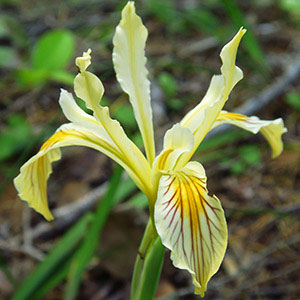Iris pseudacorus
Iris bracteata
fleur-de-lis, horticultural iris, iris jaune, pale-yellow iris, yellow flag, yellow iris, yellow water iris
Siskiyou iris
pink, freely branching, producing extensive clumps, 2–3 cm diam., with fibrous remains of old leaves;
roots fleshy.
sheathed with old leaf bases, slender, 0.6–0.9 cm diam.;
roots few, fibrous.
usually 1-branched, solid, 7–15 dm.
simple, solid, 1.5–3 dm.
basal deciduous, at first erect, then recurved, blade dark green, with prominent median thickening, 4–10 dm × 2–3 cm, slightly glaucous basally;
cauline equaling inflorescence unit.
basal with abaxial surface of blades deep glossy green on one side of fan, light yellow-green on other side, pink or red-tinged basally, strongly ribbed, 4–6 dm × 0.8–1 cm, rigid, margins not thickened;
cauline 3–6, imbricated, closely sheathing stem ca. 2/3 length, spreading distally, bractlike, blade inflated, often shorter than basal leaves.
4–12-flowered;
spathes green with brown margins, outer spathe strongly keeled, inner without keel, 6–9 cm, subequal, margins not scarious.
simple, units 1–2-flowered;
spathes closed tightly around pedicel and ovary, lanceolate, 5.2–9 cm × 6–8 mm, subequal, herbaceous, margins scarious, apex acuminate.
perianth bright yellow;
floral tube 0.6–0.8 cm, with no constriction into ovary;
sepals bright yellow or cream colored, lanceolate to ovate or suborbiculate, 5–7.5 × 3–4 cm, base abruptly attenuate, claw ca. 1/2 length of limb, signal a darker yellow basal patch limited by short, brown lines;
petals without veining, lanceolate to spatulate, 2–3 cm;
ovary triangular in cross section with concave sides and narrow groove at each angle, 1.5 cm;
style keeled, 3–4 cm, crests spreading, 1–1.2 cm, laciniate at apex;
stigmas rounded with prominent tongue;
pedicel 2.5–7 cm.
perianth cream to buff-yellow;
floral tube 0.8–0.9 cm;
sepals with deeper yellow signal, veined with purple or brown, obovate-lanceolate, 6.5 × 2.5 cm, base gradually attenuate into wide claw;
petals narrowly oblanceolate, 7–9 × 0.8–2 cm, base gradually attenuate;
ovary nearly circular in cross section, 1.5–2.5 cm, base gradually attenuate into pedicel, apex abruptly acuminate into floral tube;
style 2.2–3 cm, crests spreading, yellow, not veined, 1.2 × 0.9–1.7 cm, margins toothed;
stigmas triangular or tongue-shaped, margins entire;
pedicel 3–6.2 cm.
prismatic to oblong-ovoid, obscurely 3-angled with obvious groove at each angle, 3.5–6 cm, beak 5 mm.
nearly circular in cross section, tapering abruptly at each end, 2–2.5 × 1–1.5 cm.
D-shaped, flattened, 6–7 mm, corky, lustrous.
dark brown, irregular in shape, wrinkled.
= 34.
= 40.
Iris pseudacorus
Iris bracteata
Iris bracteata is limited to one county each in northern California and southern Oregon. It hybridizes with I. chrysophylla, I. douglasiana, I. innominata, I. munzii, I. purdyi, and I. tenax.
(Discussion copyrighted by Flora of North America; reprinted with permission.)
- Local floras:
BC,
CA,
OR,
WA
- Local Web sites:
CalFlora,
CalPhotos,
Flora NW,
Go Botany,
IL Wildflowers,
KS Wildflowers,
LA Plants,
PNW Herbaria,
Turner Photog.
WildflowerSearch
iNaturalist (observations)
USDA Plants Database
- LBJ Wildflower Center
- SEINet
- Plants of the World Online
- Encyclopedia of Life
- Wikipedia
- Google Image Search


